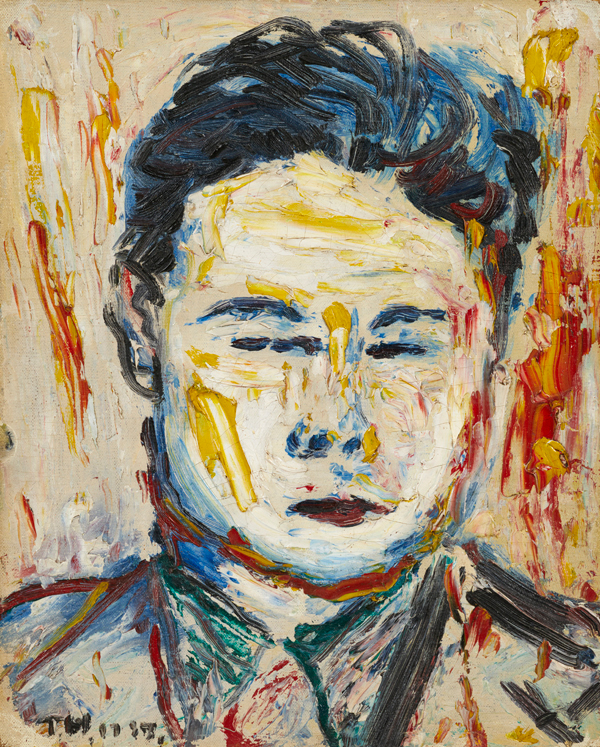Watch, Read, Listen
Recent Additions to the Collection MOMAT Collection Newsletter of the National Museum of Modern Art, Tokyo Hasekawa Toshiyuki, Portrait of Oba Tetsutaro, 1937
Back
Portrait of Oba Tetsutaro
1937
Oil on canvas board
26.9 × 21.6 cm
Donated by Kodaira Shozo, 2021
This painting appears to have been produced in the following sequence: first bright areas were roughed out in white, then navy blue and green were applied to dark areas, next contours and facial features were defined with black lines, and finally highlights were added in white, vermilion, and mustard yellow. Green appears only on the collar, and the rest of the painting employs only the five colors of white, navy blue, black, vermilion, and mustard yellow.
The subject of the portrait was Oba Tetsutaro (1910–79), then a reporter on the city desk of the Asahi Shimbun newspaper, who later became a well-known writer. Oba, who received the painting directly from Hasekawa, gave an account of its creation:
The three of us went to a nearby café, but only Amagi [Toshihiko] and I spoke, while [Hasekawa] Toshiyuki continuously drew in pencil on scraps of paper. When we returned to the gallery, Amagi went off somewhere. As if Amagi’s departure were his cue, Toshiyuki suddenly perked up and said he wanted to paint my portrait, and led me to an adjacent room. He painted the portrait on a size 3 canvas [approx. 22 x 27 cm] in just about 15 minutes. In some places he squeezed paint directly from the tube instead of using a brush. Of course, the colors were unmixed.1
While the work is relatively small, approximately the size of a standard sheet of office paper, completing it in only 15 minutes was a remarkable feat. While Hasekawa was in a particular hurry here, needing to work quickly during the brief absence of his art dealer Amagi, he was always known for the speed of his painting. His technique of painting with lines that resembled writing or scratching rather than traditional brushwork was in line with his rapidity of production.
Because Hasekawa applied new layers before the paint dried, the underlying colors naturally showed through. The characteristic heavy use of white in most of his works may have been intended to prevent colors from mixing, which would darken and weigh down the picture. Softened by mixture with white, the colors create a refreshing overall impression despite the almost violent energy of his brushwork. Here, the canvas simultaneously served as both picture surface and palette, dramatically rendering the artist’s handling, speed, and process visible.
The art critic Sawayama Ryo observed: “Hasekawa’s paintings are characterized by their permeability, the result of dispersion of lines… The city as painted by Hasekawa must have seemed plausible at a time when Tokyo was like a shimmering mirage, having arisen once more after the catastrophe of the 1923 Great Kanto Earthquake.”2 His paintings’ porous surfaces, formed by networks of linear brushstrokes, echoed the post-earthquake city of Tokyo itself, full of gaps and dotted with drafty temporary barracks. His pictorial structures resonated with his subject matter. Hasekawa Toshiyuki was a free-spirited urban drifter, and is typically described as painting in an equally anything-goes manner, but this painting prompts us to consider how the work’s content, rather than simply the way it was painted, might represent the same outlaw spirit.
[Notes]
1. Oba Tetsutaro, “Toshiyuki’s Shinjuku Era,” Collected Unpublished Works of Hasekawa Toshiyuki, Toko Kikaku, 1978, p. 81. [Content in brackets added in this text.]
2. Sawayama Ryo, “Hasekawa Toshiyuki Retrospective: The Iridescence of Tokyo – Brushstroke Networks and Permeability,” Bijutsu Techo online edition, June 5, 2018.
https://bijutsutecho.com/magazine/review/16256
(Gendai no me, Newsletter of The National Museum of Modern Art, Tokyo No.639)
Release date :


